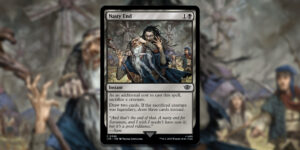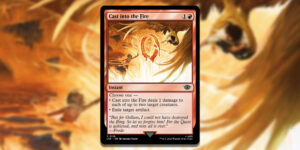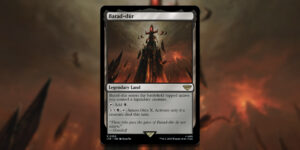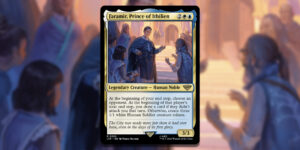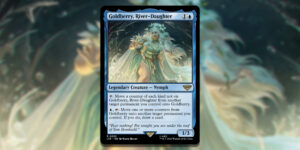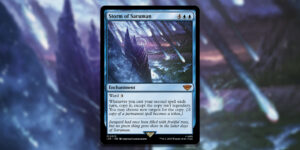It’s been about a week since The Lord of the Rings: Tales of Middle-Earth officially released. From the ashes of players frantically cracking packs in hopes of finding serialized The One Ring, several cards that were initially overlooked have risen above the others as being powerful additions to your Commander decks.
We all know how powerful Orcish Bowmasters and Aragorn the Unifier are, but what about the cards that slipped under the radar but are capable of making big plays in Commander? While these cards might not fit into every deck, and they’re not as big and splashy as many of their counterparts, they’re great cards to keep in mind when building your next deck.
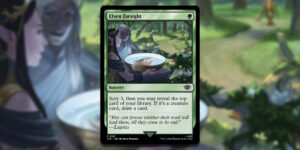
Elven Farsight
In decks with a heavy saturation of creatures, Elven Farsight is better than a Preordain at helping you dig through your deck. For just one green mana, Elven Farsight lets you scry three cards, then if you want, you can reveal the top card of your deck, drawing it if it’s a creature.
That’s a huge amount of cards to look at for just one mana, and in a deck that follows a creature type theme, like Elves or Slivers, you can reliably draw a card once you’re done scrying. Even if you don’t hit a creature, you can always tuck all three to the bottom of your deck and gamble on the top card, going four cards deep in your deck.
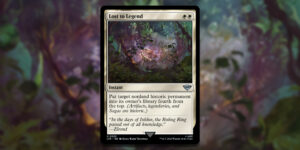
Lost to Legend
There are tons of removal available to Commander players, even though most players aren’t playing enough targeted removal to deal with specific problems on the battlefield. Lost to Legend is an odd but versatile way to deal with artifacts, legendary cards, and sagas when other alternatives are out.
Lost to Legend takes a card and puts it back into their library, fourth from the top. This isn’t a permanent solution to a problem since in a few turns they’ll have their threat back (or sooner, depending on how many draw effects they’re running). But at instant speed Lost to Legend is a great way to buy a few turns against something like a Blightsteel Colossus or losing from lethal Commander damage.
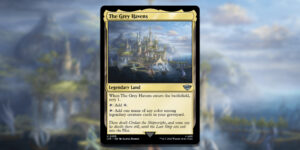
The Grey Havens
At first glance, The Grey Havens might seem underwhelming but reading a little deeper helps unlock the potential of the card. Much like the series of Temple scry lands from Theros, The Grey Havens lets you scry 1 when it comes into play. The big difference between them though, is The Grey Havens enters untapped.
While it naturally can only add one colorless mana to your mana pool, as soon as a legendary creature hits your graveyard you can add mana equal to those colors. Of course it’s a bit situational, you really do need that legendary creature to make use of The Grey Havens. However, given the higher number of legendary creatures Magic has been printing lately, particularly in the Tales of Middle-Earth set, there odds get pretty good that you’ll have one in the graveyard soon enough.
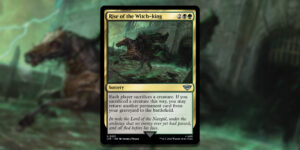
Rise of the Witch-king
Even though Rise of the Witch-king technically hurts you with its effect, it is a strong effect which can help even the odds against your opponents. For four mana, each player, yourself included, sacrifices a creature. If you sacrificed a creature this way, you can bring back any other permanent from your graveyard to play.
This makes Rise of the Witch-king a four-for-one most of the time, removing up to three of your opponent’s creatures from the board and bringing one of yours back. Even better, Rise of the Witch-king can return any permanent back to the battlefield. So you can absolutely use it to reanimate a huge creature like Razaketh, the Foulblooded, or you can use it to cheat an Omniscience back from the graveyard.
Nasty End
There are plenty of spells in black that let you sacrifice creatures to draw cards, and Nasty End is the latest iteration of this trend. What sets Nasty End apart from its counterparts is that it provides a strictly better draw effect for the same amount of mana.
As an additional cost, you must sacrifice a creature if you want to draw two cards from Nasty End. However, if that creature was legendary, you get to draw three cards instead. It rarely feels good sacrificing your commander or another legendary creature, drawing an extra card certainly helps.
Cast Into The Fire
There aren’t a ton of ways to permanently deal with artifacts. Cast Into The Fire hopes to rectify that problem. Often times if you destroy an opponent’s artifact, they’ll have some way to bring it back, letting them go on with their shenanigans.
Cast Into The Fire doesn’t just destroy artifacts, it exiles them, taking them out of the game entirely. There’s no condition you need to meet to get this done either. It’s at instant speed, letting you exile artifacts in response to a possible game-winning combo.
Barad-dur
From the cycle of five lands that check for legendary creatures in Tales of Middle-earth, Barad-dur seems to be the best among them. At first glance, it seems a bit more restrictive than the others, requiring a creature to have died this turn to activate the ability, but in Commander games where there’s three other players doing their things, you’ll be able to activate Barad-dur more often than not.
Amassing Orcs, even if it’s just for one, gives you a repeatable way to generate sacrificial tokens or chump blockers. And if it sticks for a few turns, you can dump a ton of mana into it, possibly turning it into a threat if unanswered.
Faramir, Prince of Ithilien
Playing politics in Commander can lead to some unlikely allies in the war, but with Faramir, Prince of Ithilien, you’ll find yourself on top either way. At the end of your turn, you pick an opponent. If that player doesn’t attack you by the end of their turn, you draw a card. If they did, you make three 1/1 Human Soldier tokens.
Whether it’s between card advantage or by filling the board, you’ll end up coming ahead. This type of delayed trigger requires Faramir to be in play still, otherwise, it won’t trigger. If you can keep him safe for a few turns, you’ll either have a full hand or a bunch of creatures to keep you safe.
Goldberry, River’s Daughter
At first, Goldberry, River’s Daughter might seem a bit narrow in scope. Sure you can move counters around your board, but in a build with lots of unique counters or even just a little proliferation, she can generate a ton of value over the course of a game.
The obvious use is to use Goldberry’s first ability to repeat Saga triggers, which is very good, but can only go so far. One of the goofier things you can do is use Tekuthal, Inquiry Dominus to get a few repeatable indestructible counters and then use Goldberry to start moving them to Myojin of Cryptic Dreams, which lets you remove an indestructible counter from it to copy a permanent spell three times.
Storm of Saruman
Being able to copy any spell you want is an incredibly powerful ability, and though Storm of Saruman has a catch to it, passing over this enchantment can be a huge mistake. The second spell you cast each turn gets copied by Storm of Saruman, and if that spell is legendary, the copy isn’t.
So long as you have some cheap spells you can throw in your deck to help set up Storm of Saruman’s copy effect, you can double up on anything from your commander to Time Warp effects. Stock up on spells like Ponder, Consider, and Gitaxian Probe to give you a cheap spell to cast first before dropping some bombs. Perhaps the most deceptive aspect of the Storm of Saruman is that it has ward 3, making removing it very difficult for your opponents to remove.
Ryan Hay (he/him) has been writing about Magic: The Gathering and video games for years, and loves absolutely terrible games. Send him your bad game takes over on Twitter where he won’t stop talking about Lord of the Rings.


